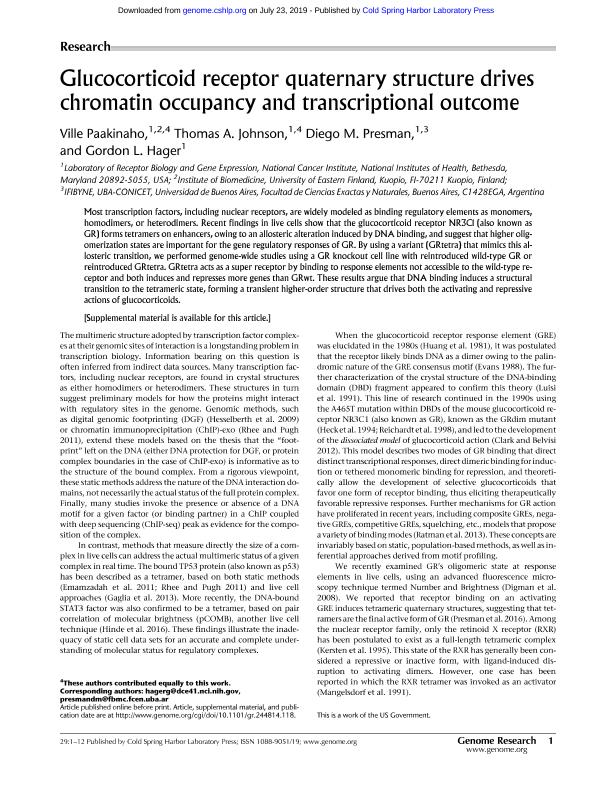Mostrar el registro sencillo del ítem
dc.contributor.author
Paakinaho, Ville
dc.contributor.author
Johnson, Thomas A.
dc.contributor.author
Presman, Diego Martin

dc.contributor.author
Hager, Gordon L.
dc.date.available
2021-01-06T17:15:27Z
dc.date.issued
2019-08
dc.identifier.citation
Paakinaho, Ville; Johnson, Thomas A.; Presman, Diego Martin; Hager, Gordon L.; Glucocorticoid receptor quaternary structure drives chromatin occupancy and transcriptional outcome; Cold Spring Harbor Laboratory Press; Genome Research; 29; 8; 8-2019; 1223-1234
dc.identifier.issn
1088-9051
dc.identifier.uri
http://hdl.handle.net/11336/121633
dc.description.abstract
Most transcription factors, including nuclear receptors, are widely modeled as binding regulatory elements as monomers, homodimers, or heterodimers. Recent findings in live cells show that the glucocorticoid receptor NR3C1 (also known as GR) forms tetramers on enhancers, owing to an allosteric alteration induced by DNA binding, and suggest that higher oligomerization states are important for the gene regulatory responses of GR. By using a variant (GRtetra) that mimics this allosteric transition, we performed genome-wide studies using a GR knockout cell line with reintroduced wild-type GR or reintroduced GRtetra. GRtetra acts as a super receptor by binding to response elements not accessible to the wild-type receptor and both induces and represses more genes than GRwt. These results argue that DNA binding induces a structural transition to the tetrameric state, forming a transient higher-order structure that drives both the activating and repressive actions of glucocorticoids.
dc.format
application/pdf
dc.language.iso
eng
dc.publisher
Cold Spring Harbor Laboratory Press

dc.rights
info:eu-repo/semantics/openAccess
dc.rights.uri
https://creativecommons.org/licenses/by-nc-sa/2.5/ar/
dc.subject
GLUCOCORTICOID RECEPTOR
dc.subject
DIMER
dc.subject
TETRAMER
dc.subject
CHROMATIN
dc.subject.classification
Bioquímica y Biología Molecular

dc.subject.classification
Ciencias Biológicas

dc.subject.classification
CIENCIAS NATURALES Y EXACTAS

dc.title
Glucocorticoid receptor quaternary structure drives chromatin occupancy and transcriptional outcome
dc.type
info:eu-repo/semantics/article
dc.type
info:ar-repo/semantics/artículo
dc.type
info:eu-repo/semantics/publishedVersion
dc.date.updated
2020-11-13T20:45:42Z
dc.identifier.eissn
1549-5469
dc.journal.volume
29
dc.journal.number
8
dc.journal.pagination
1223-1234
dc.journal.pais
Estados Unidos

dc.description.fil
Fil: Paakinaho, Ville. National Institutes of Health; Estados Unidos. University Of Eastern Finland; Finlandia
dc.description.fil
Fil: Johnson, Thomas A.. National Institutes of Health; Estados Unidos
dc.description.fil
Fil: Presman, Diego Martin. Consejo Nacional de Investigaciones Científicas y Técnicas. Oficina de Coordinación Administrativa Ciudad Universitaria. Instituto de Fisiología, Biología Molecular y Neurociencias. Universidad de Buenos Aires. Facultad de Ciencias Exactas y Naturales. Instituto de Fisiología, Biología Molecular y Neurociencias; Argentina
dc.description.fil
Fil: Hager, Gordon L.. National Institutes of Health; Estados Unidos
dc.journal.title
Genome Research

dc.relation.alternativeid
info:eu-repo/semantics/altIdentifier/url/http://genome.cshlp.org/lookup/doi/10.1101/gr.244814.118
dc.relation.alternativeid
info:eu-repo/semantics/altIdentifier/doi/http://dx.doi.org/10.1101/gr.244814.118
Archivos asociados
